Most holly species are dioeious plants — meaning they are either male or female, and each sex produces their own flowers. Only female plants produce berries, so bees are necessary to carry pollen from male flowers back to female flowers. As long as there are male plants within a 1 1/2 to 2 mile radius, pollination will occur. However, some species and cultivars are self-pollinating. Not all Ilex species are considered shrubs, and likewise, not all that are shrubs produce red berries. Those that do range in size from compact or dwarf to very large. Evergreen hollies are found in more temperate climates.
A tight row of hollies presents a formidable barrier to animals and people. Use them to divide the landscape and direct foot traffic in the garden. The dense, evergreen foliage protects your privacy and screens out unsightly views. Hollies tolerate severe pruning and sheering, so you can use them in a formal hedge, but keep in mind that sheered hollies produce few berries. They have appealing natural shapes in the forms of pyramids, domes and cylinders that need no pruning at all, making them ideal for informal hedges. Because of their strong architectural shapes, a row of hollies looks stiff and rigid, but you can soften the effect by incorporating curves into the layout.
- American holly
- Carolina holly
- Catberry (Ilex mucronata)
- Chinese holly (Ilex cornuta)
- Common winterberry
- Dahoon holly
- English holly
- Finetooth holly
- Hawaiian holly
- Inkberry
- Japanese holly
- Long-stalked holly
- Lusterleaf holly
- Myrtle Leaved holly
- Round Leaf holly
- Small-leaved holly
- Yaupon holly
- Yerba mate
- Blue holly
- Hedgehog holly
- Possumhaw holly
- East Palatka holly
- Altaclere Holly
- Burford holly
- Nana (dwarf yaupon holly)
- Winterberry
- Foster holly
- Japanese Winterberry
American Holly
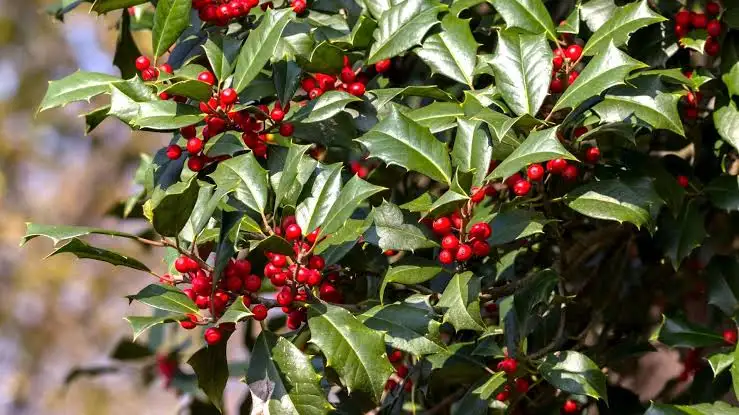
American Holly is an evergreen tree that may grow 40 to 60 feet tall. The tree has alternate leaves with spiny toothed and sometimes smooth margins. The bark is gray-white in color and may be splotched or warty. Small, dull green-white, solitary flowers mature in late spring. Female specimens produce a bright red or orange fruit which matures in the fall and persists into the winter.
As do most hollies, American holly grows best in full sun but will also grow in partial shade. American holly has several sizes of cultivars, some of which yield varying colors of berries. “Canary,” for example, has yellow fruit; “Clarendon” is a dwarf tree only reaching 8 feet tall with orange-tinted berries; and “Maryland Dwarf” only grows to 3 feet but has a 10-foot spread.
Carolina Holly
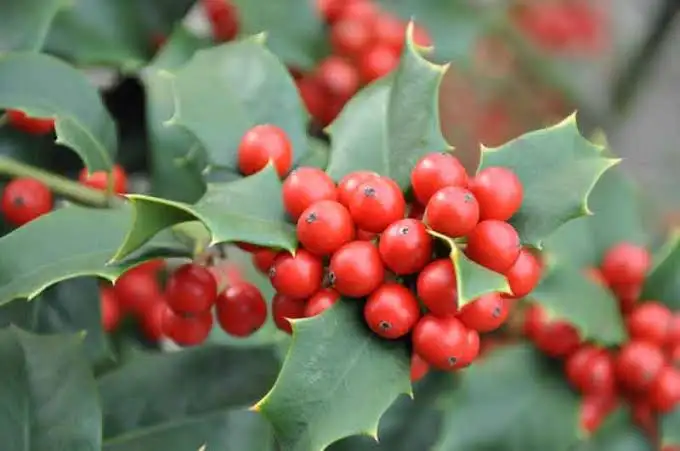
Carolina holly is a large shrub or small tree up to 6 metres (20 ft) tall. The branches are covered in shiny dark brown or black bark which becomes flaky with age. The twigs are purple.Some branches have a thick coat of fine hairs. The leaves are up to 8 inches long by 3 inches wide.The leaf margins are partially or entirely toothed or wavy.
The species is dioecious, with male and female reproductive parts occurring on separate individuals. The fruit is a spherical red drupe. The seeds are dispersed by animals, which eat the fruits.
Also Read: Trees And Shrubs With Winter Berries To Grow In Your Yard
Catberry or Mountain holly

Mountain holly is a deciduous shrub growing to 3 m (rarely 4 m) tall. The leaves are alternate, simple, elliptic to oblong, with an entire or finely serrated margin and an acute apex, and a petiole. The tiny flowers with 4 to 5 petals are inconspicuous, whitish to greenish-yellow, produced on slender peduncles, usually dioecious, with male and female flowers on separate plants. The fruit is a red drupe containing three to five pits.
Chinese holly

Chinese holly is a broadleaf evergreen shrub that can grow up to 8 ft tall. It has been recorded as growing up to 25 ft tall. Leaves are rectangular that have 4 to 5 spines on the leaf margin. The glossy and leathery leaves are simple and alternate on the stem. Flowers begin to bloom during the early spring and are a dull white color and have a fragrance.
The flowers produce red berries that ripen in early fall. The bark is a light gray color and smooth. As it grows, the bark turns into a finely flaky appearance. The stem of Chinese holly is either green or a red to burgundy color depending on the season. The green stems turn slightly more red during the winter months.
Winterberry

Winterberry is a deciduous tree that may grow 10 to 15 feet tall, but it often occurs in the wild as a shrub. The leaves are alternate with a sharply toothed margin and hairy underside. The bark is thin, smooth, and gray-brown. In spring, stalked, yellow-green flowers mature in clusters. Female specimens produce red-orange drupes that mature in the fall.
The name winterberry, comes from the red berries that provide winter interest and sometimes persist into early spring (if the birds don’t eat them). The berries appear just as the leaves are dropping in the fall. Winterberry holly is often associated with the Christmas holiday season and their berry-laden stems are used to add color to evergreen arrangements.
Dahoon holly
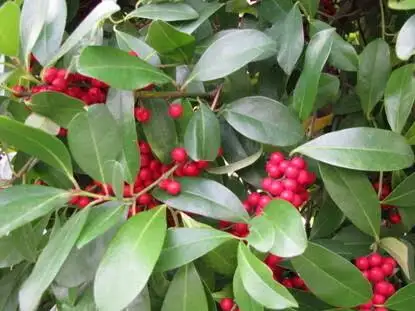
Dahoon holly is a small, low-maintenance broadleaf evergreen tree that adds color to your garden in the cooler months. It has glossy dark-green leaves that lack the spiny edges found on many hollies; the plant can grow as a large multi-stemmed shrub or small tree trained with one leader to serve as a trunk. Female plants display white flowers in spring, followed by red berries that persist through winter as they attract wildlife.
It gladly accepts shaping through hard pruning, and has even been used in bonsai culture.This tree has a slow to moderate growth rate, adding 10 to 20 inches of growth per year. The berries of dahoon holly, like many other holly species, contain saponins that are mildly toxic to humans, causing digestive upset if the berries are consumed.
Also Read: Different Types of Trees And Shrubs With Red Berries
English holly

Also sometimes referred to as Christmas Holly or Common Holly, this slow-growing, ornamental, densely-branched evergreen tree can easily grow up to ten meters. It can also be trained to grow as a tall shrub. English holly is commonly used landscape ornamental often used for holiday decorations and floral arrangements.
Though best known for its decorative qualities, English holly is also useful for habitat gardens. The tiny white flowers that appear in mid spring are excellent nectar sources for bees, while the berries are favorites of birds and other small animals.
Finetooth holly
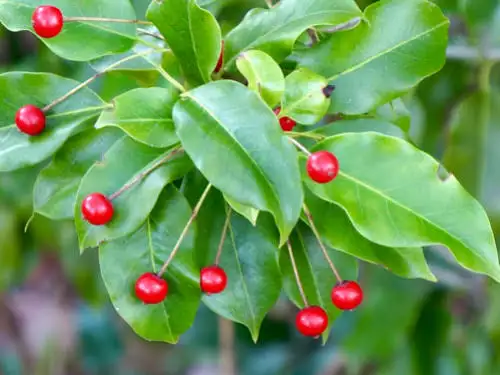
Finetooth holly resembles winterberry except for two traits: Its berries are smaller and it’s semi-evergreen, not deciduous. It doesn’t drop all its leaves in fall. A popular bonsai specimen grown in various upright, slanting and cascade styles.
This variety has densely packed and small deep green, glossy leaves that sometimes get this tree confused with Japanese Box. Producing lovely purple flowers followed by fine red fruit, this tree makes for an attractive and compact specimen.
Hawaiian holly
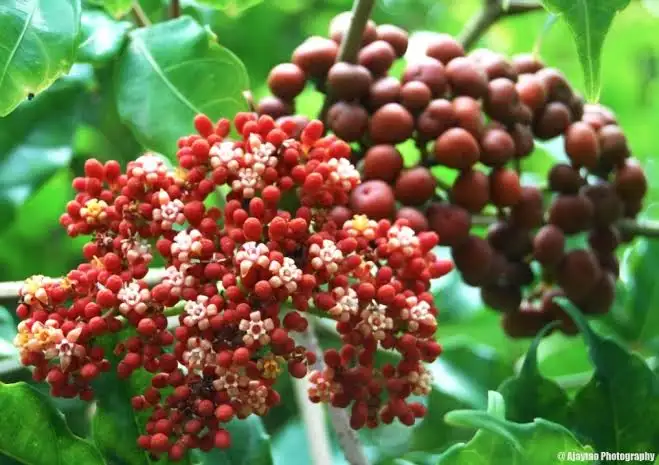
Hawaiian holly West Indian Holly ‘Rubra’ is a rare but a perfect plant with foliage that is bronzy red when young but turns green when mature. The variety Burgundy maintains the red foliage color in good light. It grows to a height of 6-8 ft.
Hawaiian holly flowers are attractive to wasps, bees, butterflies, flies and bettles which act as potential insect pollinators. However it rarely blooms when grown indoors. The plant produces red flowers which later turn pink. The fruits are black berries.
Inkberry

The name “inkberry” is a clear reference to the fruits produced by the shrub, as is the plant’s secondary common name, “gallberry.” This alternate name derives from the fact that black ink was once made from the galls of oaks. It’s a broad spreading, semi-stoloniferous shrub 6 to 8 feet tall and 8 to 10 feet wide. Branches are mostly upright with non-spiny, richly evergreen 2-inch long leaves. The leaves congregate near the ends of the branches. With age, plants tend to drop their lower leaves and become a bit leggy.
Like all hollies. this species is dioecious with male and female clones. The flowers appear in late spring as new growth appears but are of no ornamental significance. Female plants, if there is a male around for pollination, produce pea-sized black berries that remain on the plant through the winter but are scarcely noticeable. It grows naturally in sandy woodlands, at the edges of swamps and bogs, and on sandy dunes.
Also Read: Different Types of Evergreen Shrubs For Your Home Garden
Japanese holly or box-leaved holly

Japanese holly plants grow into dense, rounded bushes between 3 and 10 feet tall and wide, with lustrous leaves and a compact habit. Some grow slow and some relatively fast, so pick your cultivar carefully. The shrubs offer small, greenish white flowers in springtime but they are neither fragrant nor showy. The flowers give way to small, black, rounded fruits. Japanese holly has a slow growth rate and can be planted in the fall or spring.
Longstalk holly
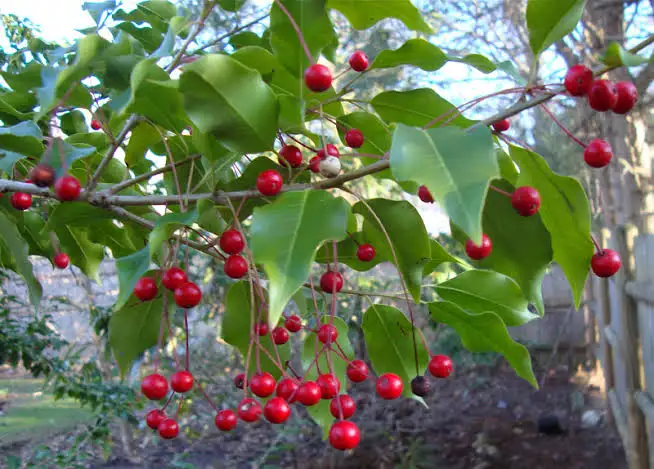
Long-stalk Holly is a very hardy evergreen with red berries, small, pleasantly scented flowers, and showy foliage that is spineless and much like mountain laurel. The fruits are relished by birds and hang down on long stalks. The distinctive berry stalk is known as a peduncle, hence the species name. It can be pruned as a dense broad shrub or left to grow as a small tree.
The spiny leaves make this a good choice for a barrier or privacy screen or use as an impenetrable hedge. It can also be planted as a specimen, used in small groups, or planted along a foundation.
Lusterleaf holly

The Lusterleaf holly is a very un-holly like evergreen that could be mistaken for a Southern magnolia. The large, glossy leaves are smooth, tapering and up to 10 inches long, with no spines and just the hint of a serrated edge. This tree grows rapidly, adding 3 or 4 feet a year, and soon it will be over 20 feet tall and around 10 feet wide, with one or more sturdy trunks and a pyramidal to rounded crown.
It can potentially produce a crop of attractive clusters of orange-red berries in fall and into the winter months. Grow this tree near wooded areas, on a large lawn as a handsome specimen, or around your home.
Round Leaf holly
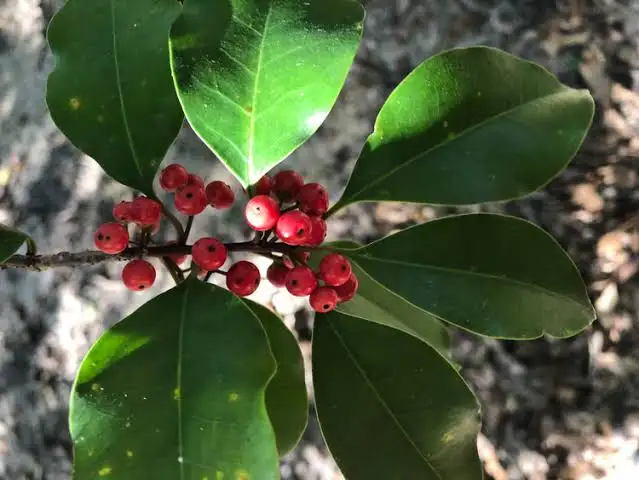
The Kurogane Holly or Round Leaf Holly is perhaps the rarest of the many hollies that occur in Jungle Gardens. It is one of the most attractive Holly species in cultivation, producing tremendous clusters of bright red berries in fall months. Their dark green leaves are spineless as is the entire plant. This evergreen tree can reach a height of 50 feet.
Small-leaved holly
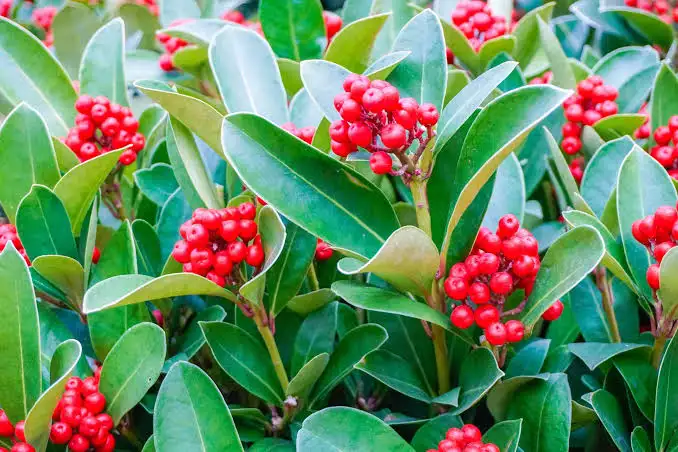
Small leaved-holly is a shrub or small tree up to 7 meters tall and sometimes 10 m high, evergreen, with a gray trunk. It has glossy ovate leaves, usually whole rounded edges in the leaves and only a few small spines; iota obtuse or rounded. The leaves have ovate to ovate to lanceolate, bright and whole. The young leaves can be as thorny.
The flowers are small, clustered in axillary inflorescences. The flowers are having four to six white petals, the flowers are located in subterminal leaf axils. It blooms from May to June. The fruits are globular, fleshy, red and located on stems of 3–8 mm long.
Yaupon holly
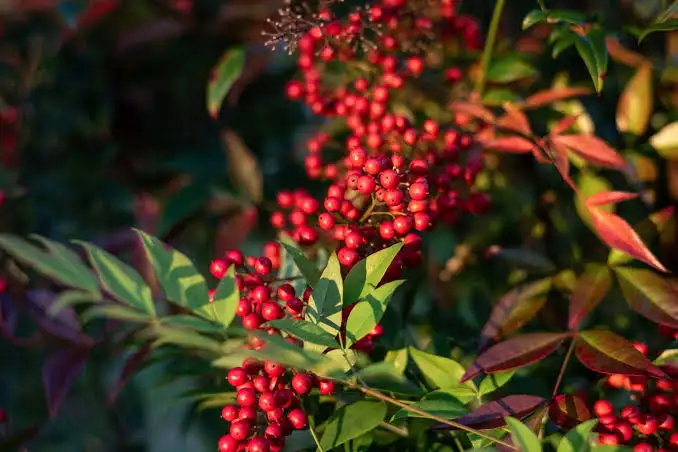
The yaupon holly is an evergreen shrub or small tree with green leaves and red berries that will add color to your garden throughout the year. The glossy green leaves are oval, up to one inch long, and feature fine-toothed margins. The tooths on the margin may be pointed or rounded.
Each plant produces little greenish-white male or female flowers in the spring, though only the females will bear fruit—small berries that are usually red but sometimes yellow. Yaupon hollies naturally grow in a basic round form, but pruning gives them a neat, rounded shape. Tip pruning results in a flourish of new growth at the tips, so you must trim the holly regularly to maintain the shape.
Also Read: Different Types of Crape Myrtle Trees And Shrubs
Yerba mate
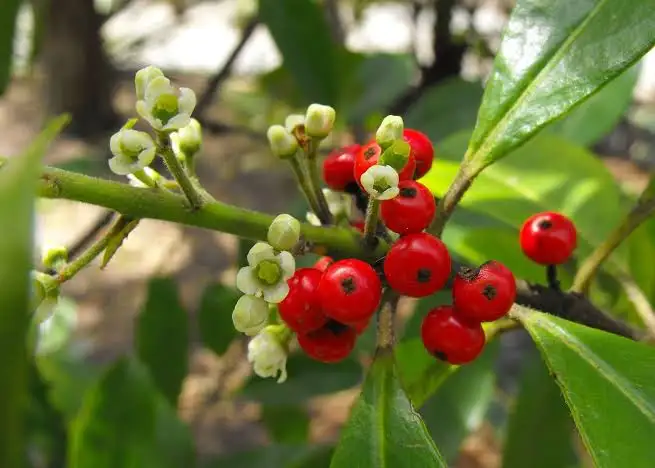
It starts as a shrub and then matures to a tree, growing up to 15 metres (49 ft) tall. The thick, dark leaves provide color and interest year-round, and small white flowers also blossom in late fall and early winter. In late spring and early summer, small red berries appear on the tree which the seeds come from.
The leaves are often called yerba (Spanish) or erva (Portuguese), both of which mean “herb”. They contain caffeine (known in some parts of the world as mateine) and related xanthine alkaloids, and are harvested commercially. Yerba Mate can be grown successfully indoors in pots, but it has pretty specific requirements for outdoor planting.
Blue holly

‘Blue Princess’ or blue holly has a moderate growth rate compared to other hollies, adding one to two feet per year. Its leaves are glossy, dark green with a bluish cast and moderately spiny. The inconspicuous flowers bloom in the spring and are followed by bright red berries that remain on the shrub into winter.
The best time for planting is in the early fall, though spring planting can also work in colder regions. Warm climates benefit from fall planting, so the roots have time to develop before the summer heat arrives.
Hedgehog holly
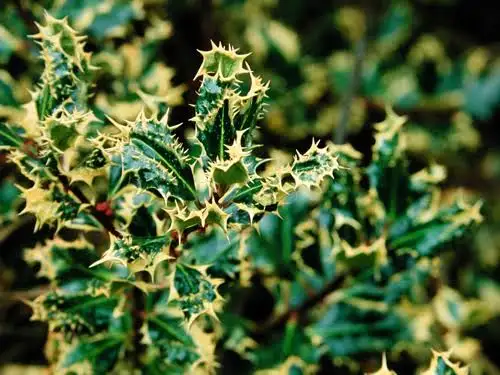
Hedgehog holly is a large, bushy evergreen shrub with small, shiny, spiny leaves, both on the upper leaf surface and along the edges. Borne on rich purple twigs, the foliage is adorned with broad creamy-white edges. Abundant small white flowers are produced in spring, which give way to a profusion of attractive bright red berries on female plants in fall.
Extremely showy, they enliven the winter landscape and persist throughout winter. Durable and long-lived, this holly provides excellent year round interest and contributes to lovely home decorations.
Possumhaw holly

A rare deciduous holly, possumhaw’s narrow glossy green leaves turn yellow in fall, revealing branches covered with red berries. Most plants are dioecious but some have perfect flowers with both male and female parts.
Possumhaw grows as a large shrub, from 7 to 15 feet tall and 5 to 12 feet wide. Possunhaw makes a good rain garden plant because it tolerates both wet and dry soil. Possumhaw holly adds fall interest to the garden, becoming most bold after leaf drop when berries clothe the stems.
East Palatka
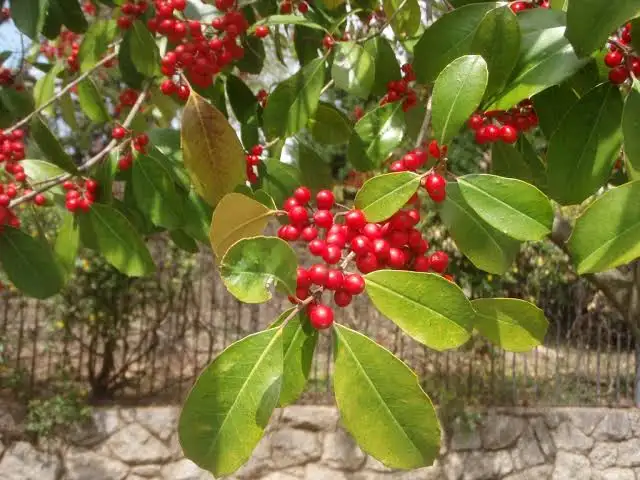
The East Palatka holly is a drought-tolerant hybrid tree that grows and reaches a mature average height of 40 feet. It bears rounded, dull green leaves; creamy flowers; and bright red berries that appear in fall and winter, attracting wildlife.
It’s an ideal option for landscape design, because the tree grows uniformly without requiring excessive shaping and has a narrow trunk that suits urban environments. Use these hollies to line a sidewalk or driveway or as a privacy hedge.
Altaclere holly
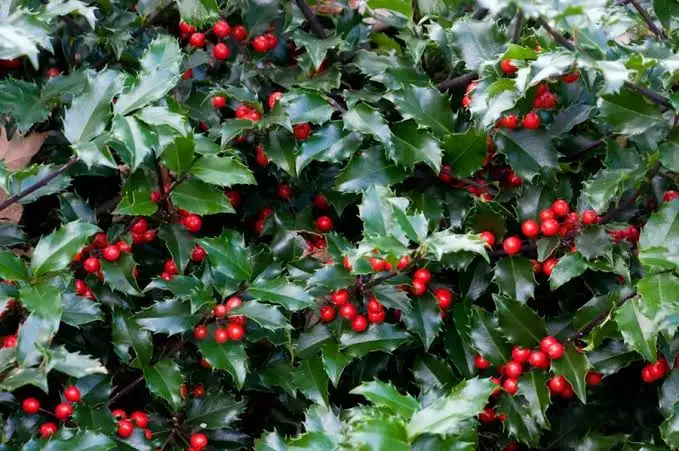
The Altaclere holly is another evergreen that has lustrous dark-green leaves. Its relatively large, bright-red berries contrast nicely with the deep-green foliage. This pyramidal tree reaches from 20′ to 30 feet tall at maturity.
The spiny leaves make this a good choice for a barrier or privacy screen or use as an impenetrable hedge. It can also be planted as a specimen, used in small groups, or planted along a foundation.
Also Read: Major Types of Walnut Trees And Shrubs
Burford Holly

Burford Holly is a dense evergreen shrub or small tree with glossy, dark green leaves, each with a single terminal spine. Leaves are among the glossiest and darkest green of trees. The somewhat-showy clusters of fragrant, springtime, white flowers attract bees. The large, bright red, long-lasting berries during the fall and winter provide a nice contrast to the dark green leaves.
Burford Holly can also be trained as an attractive vase-shaped multi-stemmed small tree. Trees trained in this fashion often have a thick crown comprised of many branches and trunks. The Burford holly grows 15 feet tall and wide. Some gardeners opt to train the holly to grow as a tree that can reach up to 25 feet tall.
Dwarf yaupon holly
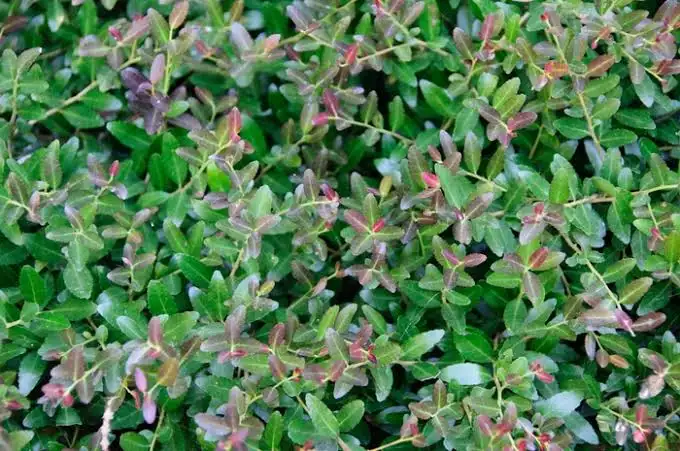
Dwarf yaupon holly is a slow-growing mounding shrub. It is the compact habit of this plant that leads many gardeners to plant the dwarf yaupon holly along borders and in front of tall, leggy flowers. The plant feature small orange to red fruits and small oval leaves and, unlike other hollies, the leaves aren’t prickly.
Yaupon holly is highly adaptable to a wide range of conditions, thriving in both sun or shade, clay or sandy soil and acid or alkaline soil, making this evergreen well-suited for gardeners who lack a green thumb. Cultivars within the species come in a wide range of forms, providing virtually limitless landscaping uses. Dwarf yaupon holly works well for shohin bonsai, quite small at between 6 and 10 inches, and for medium bonsai sizes, which may grow as large as 18 inches tall.
Foster holly
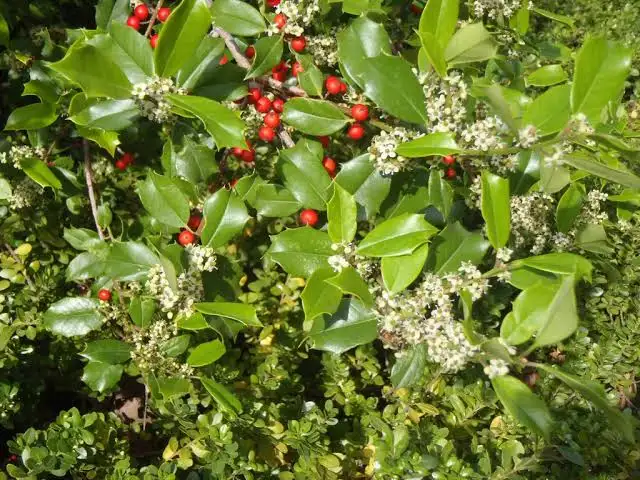
Foster Holly is a beautiful evergreen small tree that is unique among hollies for flowering without a second tree to pollinate it. It will grow in sun or partial-shade and it will be smothered in bright red berries all winter long. This tree will grow to 25 feet as a beautiful specimen tree or it can be planted as an attractive screen, or trimmed into a beautiful dense hedge.
The deep-green leaves have small spines on them and they are glossy and healthy-looking all year round. In spring your tree will have small white flowers which develop into the traditional holly berries loved by everyone for the holiday season.